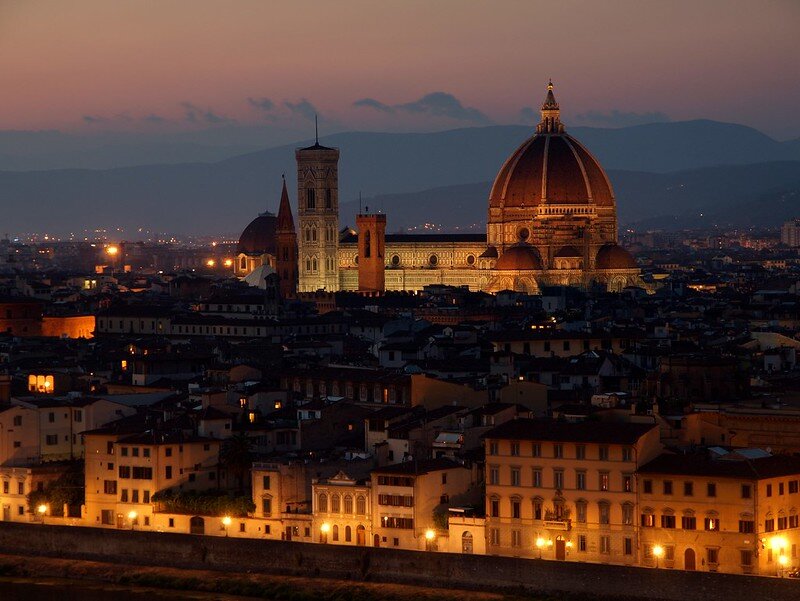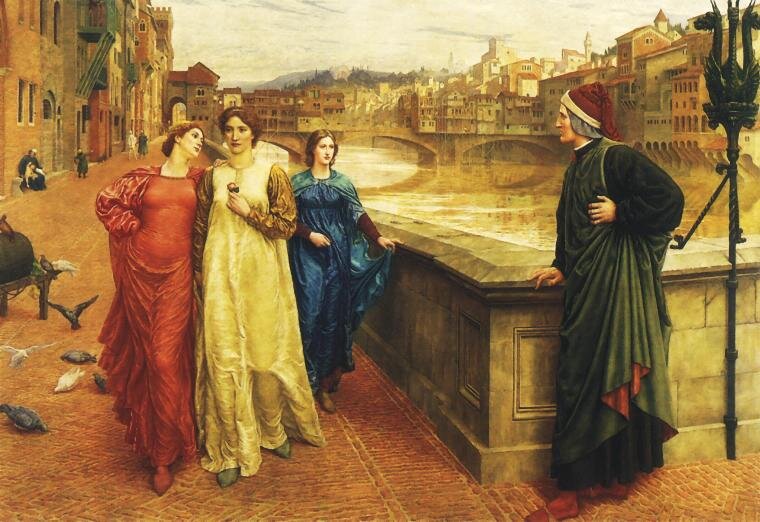The Power of Love, According to Dante
Ben Curtis | benjamincurtis.me
One of the greatest writers about love, in any language, is the medieval Italian poet and philosopher Dante Alighieri. You might not associate Dante with love, since in the English-speaking world he’s most famous for the phantasmagoric vision of hell in his Inferno, the first of his three-part Divine Comedy. But love is absolutely fundamental to Dante’s artistic output. Nowhere is this clearer than in his first published work, Vita nuova, which dates to about 1295.
Vita nuova translates to “new life,” and through prose and poems Dante describes his relationship with the love of his life, Beatrice. These two first met in Florence when they were nine years old, and then again when they were 18. The early poems in Vita nuova show Dante as a young man besotted with Beatrice’s beauty, love-sick like a hormonal teenager. As in any pop-culture romance, his infatuation has its ups and downs. He’s devastated when Beatrice refuses to greet him in the street. He even has a dream in which Love appears to him personified, and feeds Dante’s heart to Beatrice.
Florence—Dante’s and Beatrice’s hometown
Image | Martin Sojka
Strange as that dream may sound, you have to read it (and the whole work) allegorically. This is because Vita nuova is a product of medieval culture; Dante cloaks his meaning in a complex layer of symbolism. That symbolism points to how Dante’s love for Beatrice takes on a much deeper meaning as the years go on. As the work progresses, we see that Dante as an older man has constructed it to show that he’s actually on a journey, looking back on how his love evolved.
Dante (in green) and Beatrice (in yellow) on the Ponte Santa Trinità in Florence (painting by Henry Holiday, 1883)
Image | Google Art Project
We can see the evolution in one of the work’s most famous sonnets — this indeed is one of the most famous poems in the Italian language. Known by its opening line of “Tanto gentile e tanto onesta pare,” you can read it below in a translation by the nineteenth-century English artist Dante Gabriel Rossetti. His translation is a bit old fashioned, but I think it’s prettier than some of the more contemporary free verse versions.
My lady looks so gentle and so pure
When yielding salutation by the way,
That the tongue trembles and has nought to say,
And the eyes, which fain would see, may not endure.
And still, amid the praise she hears secure,
She walks with humbleness for her array;
Seeming a creature sent from Heaven to stay
On earth, and show a miracle made sure.
She is so pleasant in the eyes of men
That through the sight the inmost heart doth gain
A sweetness which needs proof to know it by:
And from between her lips there seems to move
A soothing essence that is full of love,
Saying forever to the spirit, “Sigh!”
Source: Dante Alighieri, Vita nuova, Dante Gabriel Rossetti, translator, 1899. Available at Project Gutenberg.
If you want to practice your medieval Italian, the original is below. You can also listen to it recited by a native speaker.
Tanto gentile e tanto onesta pare
la donna mia, quand'ella altrui saluta,
ch'ogne lingua devèn, tremando, muta,
e li occhi no l'ardiscon di guardare.
ella si va, sentendosi laudare,
benignamente e d'umiltà vestuta,
e par che sia una cosa venuta
da cielo in terra a miracol mostrare.
Mostrasi sì piacente a chi la mira
che dà per li occhi una dolcezza al core,
che 'ntender no la può chi no la prova;
e par che de la sua labbia si mova
un spirito soave pien d'amore,
che va dicendo a l'anima: Sospira.
Source: Wikipedia
When I used to teach Dante in my medieval European history class at Seattle University, I’d ask students what they thought of this poem. I particularly wanted to know from the women students, “Would you like it if a man described you this way?” A lot of them thought it was kind of creepy, or would object to being put on a pedestal as Dante does to Beatrice. What might make it seem even creepier is that though Dante wrote all these poems to Beatrice, they never married. In fact, they barely ever spoke, since (spoiler alert!) the historical Beatrice died when she was only 24.
So Dante’s love for Beatrice was never requited in any traditional sense; they met only twice in their lives, and he married another woman. But it wasn’t unusual in medieval love lyrics to pine for a lady from afar, and poets typically exalted their beloved with lofty language. Dante’s artistic genius is that he changes both what it means to love from afar, and how the beloved is exalted. Look at how he describes Beatrice in the poem: “seeming a creature sent from Heaven,” “a miracle made sure.” Beatrice is so humble, gentle, and pure, that when people merely look at her, they feel a sweetness that makes them sigh. She’s not just a hottie: she’s a blessing to everyone who encounters her.
Dante’s Dream at the Time of the Death of Beatrice (painting by Dante Gabriel Rossetti, 1871)
Image | Wikimedia Commons
My students often thought it was kind of a cop-out that Dante and Beatrice never smooched. To Dante, though, it didn’t matter that his love for Beatrice remained unconsummated. Why? Because merely the act of loving her was enough. Loving someone was its own justification.
How could this be? It connects to how Dante’s understanding of his love for Beatrice evolved. By the end of Vita nuova, Dante has come to understand that his youthful love was superficial. Instead, he realizes that his love for her is his most direct experience of the divine nature of love. Beatrice, after all, was “sent from Heaven,” a gift from god. By loving her — even if it’s from afar — Dante is himself purified, brought to a new spiritual existence, brought closer to god. This is one reason why the work is titled Vita nuova: Dante’s love of Beatrice grants him a new life.
The medieval love poets who preceded Dante typically didn’t make these religious connections to love. And though Dante’s ideas are wrapped up in Christian theology, you don’t have to be a Christian to find them beautiful. His account of love as transcendent and transformative is relevant even if you’re an atheist. He sees love as the highest power in human life. For Dante, Beatrice was the object, the symbol, and the channel for this power, even if they never so much as held hands. In fact, in the final part of the Divine Comedy, Dante writes of Beatrice again. She leads him into heaven, where he has a vision about the centrality of love to all of existence. The very last line (spoiler alert again!) of that monumental poem is: “L’amor che move il sole e l’altre stelle” / “Love, that moves the sun and the other stars.”
This is a vision of love as the power that drives the entire universe. No poet has ever expressed it more profoundly, or more beautifully, than Dante.



